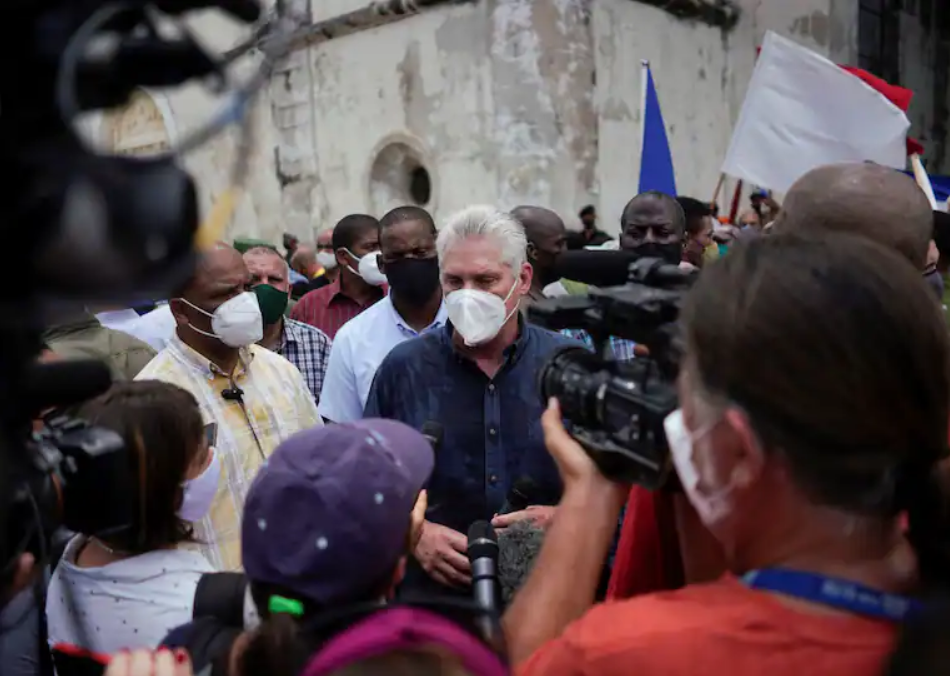It is an irony of history that when China is celebrating the centenary of its party, the Communist Party of China (CPC), another communist country, Cuba, is confronted with the biggest mass demonstrations for three decades against food shortage, high prices, power outage and one-party political system. As thousands of protesters took to the streets in towns across Cuba, it was not simply an expression of nationwide anger against a temporary economic crisis compounded by the Covid-19 pandemic. The outpouring of anger is a tell-tale manifestation of the people’s lack of faith in the Cuban variety of communism that has failed to improve the common man’s quality of life. This is mainly because Cuban communism has all these years been doggedly refusing to effect economic reforms or combine socialism with the market forces the way Chinese communism has done to emerge as the second largest economy of the world.
The assertion by Cuban President Miguel Díaz-Canel July 17 that the protests are nothing but a black ‘lie’ spread by the USA does not cut much ice as images circulated on social media sites in Cuba clearly show all’s not well. The protests began in the morning of July 11 in the town of San Antonio de los Baños in the west of the island. With millions of Cubans now with mobile internet on their phones, news of the protests quickly swept to Havana and thousands erupted in central Havana chanting ‘homeland and life’ and ‘freedom’. This was a parody on the clarion call given by Cuba’s Communist liberator Fidel Castro in the 1950s – ‘homeland or death’. The protesters are angry because there is an acute shortage of basic food and medicine and there are power-cuts in the current spell of gruelling heat. The common refrain of the protesters is change of government, multiparty elections and end of communism.
Even if there is an element of truth in the Cuban President’s charge that the USA is engineering the demonstrations to overthrow Communist rule in Cuba, fact remains that the Cuban economy is collapsing for a combination of factors including the rulers’ refusal to reform it for the past 30 years. The Trump administration dealt a severe blow to the island’s economy with over 200 new sanctions aimed at sabotaging Cuba’s economy and stirring discontent. The measures are being continued by his successor Joe Biden. The pandemic has worsened the crisis with drastic fall in tourism, a key revenue earner for Cuba, drop in remittances contributed by Cubans working in the USA and the crude oil crisis in friendly Venezuela.
Cubans have become accustomed to waiting in queues for hours to buy basic goods such as chicken and detergent. Medicines have disappeared from pharmacy shelves.
Cuba had witnessed the biggest protests in 1994, when tens of thousands demonstrated at Havana’s Malecón promenade amid an acute economic crisis brought on by the fall of the Soviet Union. But, the charisma of Fidel Castro had bailed the Communist rulers out at that time.
Now, Cuba’s economy is struggling like never before and Miguel lacks Castro’s stature. Apart from the toll the pandemic has taken on tourism, the poor harvest of sugar this season has hit the economy hard. Sugar, which is mostly exported, is a key earner for Cuba. As a result, the government’s reserves of foreign currency are depleted and it is unable to buy imported goods to supplement shortages, as it would normally do.
But, the main problem that has brought this crisis to Cuba is the country’s Soviet-style, centrally planned economy and its hesitation to adopt market-oriented reforms that other remaining communist countries have taken up. Its economy has contracted by over 35 per cent and it never recovered from the crisis the collapse of the Soviet Union in 1991 plunged it into, economists say. At the same time Cuba did not heed advice from China and Vietnam to reform its economy. During an official visit in 2018, the general secretary of Vietnam’s Communist Party, Nguyen Phu Trong, urged Cuba to adopt the model of market economy as Vietnam had done in the 1980s. Over 30 million Vietnamese were lifted out of poverty in the wake of the new experiment. Cuba’s government owns and operates most industries, while most of the labour force is employed by the state.
Faced with severe shortages of food and medicine, Díaz-Canel recently picked up the pace of reforms, unifying the country’s dual currency and legalising the status of private businesses allowed to operate decades ago. He also promised more movement in that direction. But for the average Cuban, the reforms are too little, too late and they lack credibility. Former leader and brother of Fidel, Raul Castro had also promised ambitious economic reforms in 2011, but they were never fully implemented.
Hence, it won’t serve much purpose to the current Cuban leadership either to see an American plot in the spate of protests or put down massive demonstrations with an iron hand. The challenge is to the economic model and political ideology and the response will show the mettle of the leadership.
